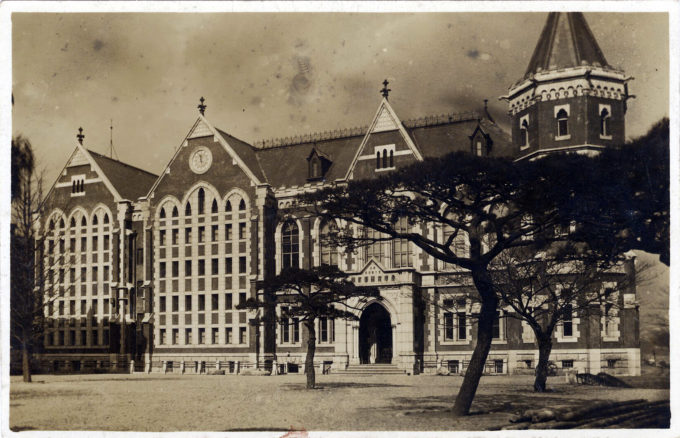
Keio University library, Ikebukuro, Tokyo, c. 1920. Completed in 1915, the library remained standing until incorporated into the present-day Keio Mita Media Center in 1982, surviving both the 1923 Great Kanto Earthquake and the Pacific War.
See also:
Keio University Hospital, Tokyo (Shinanomachi), c. 1920.
Keio University baseball players on the field, c. 1910.
The origin of the main library of Keio University traces back to the vision of Fukuzawa Yukichi, the founder of Keio University, who emphasized the importance of Western learning and research. Fukuzawa believed that a comprehensive library was essential to Keio’s mission of fostering academic inquiry and innovation in Japan.
In 1912, Keio University officially began constructing a dedicated library building on its Mita Campus in Tokyo, to centralize its collection of Western books and Japanese materials. The library was designed by the architect Kikuta Shinshichi, who incorporated Renaissance Revival architectural elements to give the building a sense of grandeur and permanence, reflecting the university’s commitment to higher learning.
Completed in 1915, the library became one of the first modern academic libraries in Japan and a symbol of Japan’s push to modernize its educational institutions. The building’s Western-style architecture was emblematic of the university’s emphasis on Western knowledge and its aspirations to be at the forefront of Japanese education.
The library’s initial collection included many Western texts, especially in the fields of social sciences, law, and literature, which Fukuzawa had personally imported to serve as resources for students and faculty. Over time, the library expanded to house rare manuscripts, archival materials, and special collections related to Japanese history, economics, and Fukuzawa’s works, contributing to its status as a premier research library.
The Keio University Library has undergone several expansions and renovations since its initial construction. The original 1915 building remained a core part of the library until it was expanded and incorporated into the Keio Mita Media Center in 1982.
Today, Keio’s library system is one of the most comprehensive university libraries in Japan, with a collection that spans multiple disciplines and includes both physical and digital resources, continuing the legacy envisioned by founder Fukuzawa in the early 20th century.

